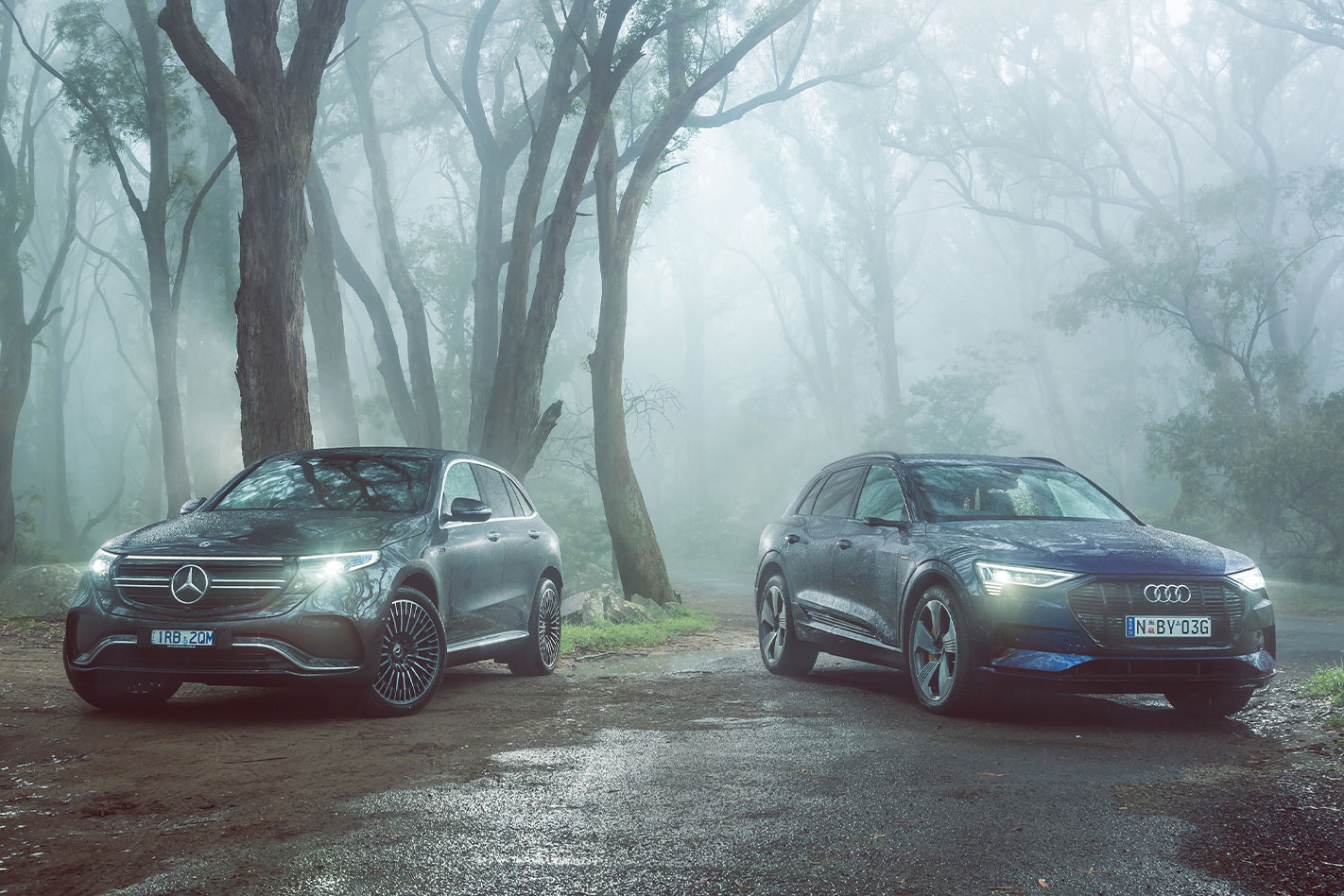It’s a pretty abstract concept, this whole ‘future’ thing. But here’s one indicator you may have noticed: it doesn’t actually feel like the future. Instead of being startlingly unfamiliar and difficult to navigate, it actually feels the way things should have always been.
Perhaps you remember Apple founder Steve Jobs on stage unveiling the then-new iPhone back in 2007. If you were like me, your first thought was: “This guy sure doesn’t spend his billions in clothing stores.”
But then, watching as the iPhone’s multifunction smarts and user-optimised interface were explained, you may have sat there going: “Of course. Makes complete sense. Why did anyone bother trying to do it differently?”
I’m experiencing that overarching sentiment from behind the wheel of Audi’s first mainstream EV as I thread it down a jinking, winding backroad in the lush, green Southern Highlands of NSW. Ahead of me, former Wheels Road Test Editor Nathan Ponchard is not sparing the watts to our 2020 Car of the Year, the Mercedes-Benz EQC.
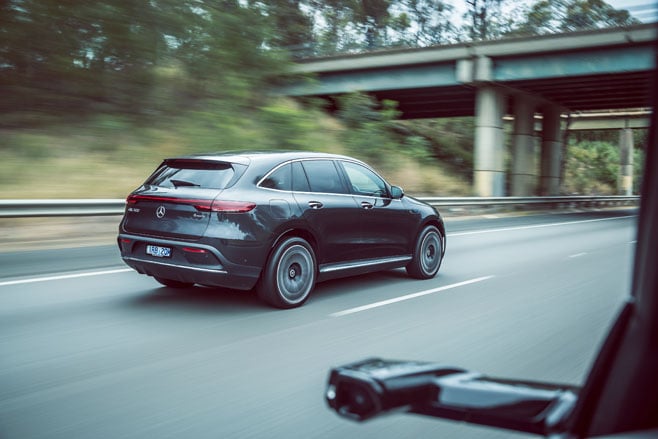
The pace is on, but the in-cabin tranquillity of the e-tron is that of a Bentley being used to chauffeur royalty. The tyres generate only a distant hiss on the bitumen, the air slips quietly over the aero-tweaked body, yet the corners arrive with a furious but soundless rush.
Later Ponch and I will dig a bit deeper into the downsides of trading combustion for electric motors, but right now there are a couple of irrefutable facts. One, this pair mirror the broader direction of the global automotive industry, and that course is unequivocally set.
And secondly, if you ignore for a moment the questions of green credentials and cradle-to-grave impacts, instead just focusing on the fundamental user experience, well, it’s quite brilliant.
As will become clear, both cars achieve such high levels of refinement, driveability and polished ease of daily operation that to separate them will require a greater drilling into other elements of the ownership experience. So let’s start with choice, prices, equipment and charging.
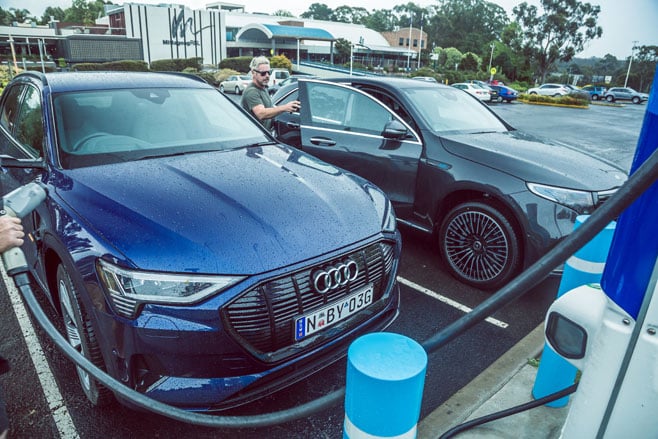
Straight away, the four-strong e-tron line-up gets a leg up over its one-model-fits-all Merc rival. The Audi may be late to the Aussie market – Wheels first drove the car in Abu Dhabi in 2018 – but it arrives here offering two battery/output options, each available in either conventional SUV or sloping-roof Sportback body styles.
Cheapest way in to e-tron ownership is with the 50 quattro SUV, with its 71kWh battery feeding two motors (front and rear, permanently excited synchronous) combining to provide 230kW/540Nm, and priced at $137,700.
The regular range tops out with the 55 quattro Sportback at $157,700, the ‘55’ designation indicating a larger battery (95kWh) and higher output motors (for a short-burst maximum of 300kW/664Nm). For anyone undeterred by those sort of numbers, some 70 units of a higher-spec ‘First Edition’ model are offered for both ‘55’ body styles, adding around $13K for their rich equipment lists. Our test car is a 55 quattro SUV First Edition, priced at $159,000 and bumped up as-tested only by $2300 for metallic paint.
A better match, at least on price, would have been the e-tron 50 SUV, because in terms of battery capacity Merc’s EQC 400 packs an 80kWh unit that wedges itself, energy-wise, between the two Audi options.
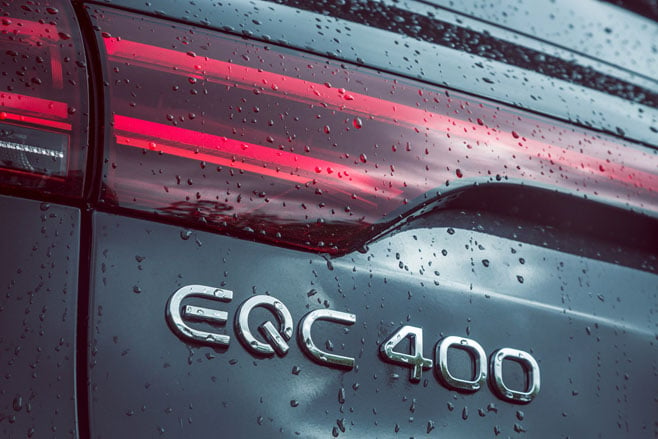
The Merc’s dual (asynchronous) motors, though, boast sizeable numbers, with combined power (300kW) bang on par with the 55 e-tron but torque (760Nm) some 96Nm stronger.
This is reflected in the EQC’s quicker claimed 0-100km/h time of 5.1sec, versus the 55 e-tron, which concedes around half a second, even when boost mode is deployed while you’re in the Sport drive mode.
But all this is really brochure posturing because, as quickly becomes evident, standing-start sprints with flattened accelerator pedals are even less relevant and less sensible in big, heavy EVs than they are in conventional ICE SUVs.
However, to provide an early answer to the first question, guaranteed, from every casual observer – “How far does it go on a charge?” – and the answer (equally guaranteed) of “that depends”… Reality is, there are a number of other factors that impact consumption compared to ICE engines.
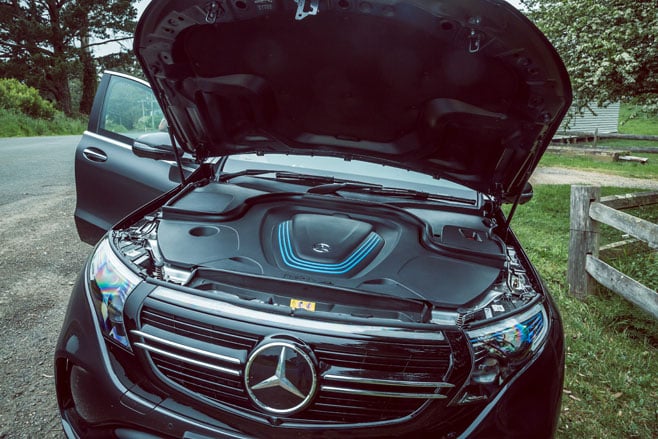
Common to both are heaviness of the driver’s boot, but re-gen opportunities, topography, temperature and ancillary use also play a part. Official WLTP numbers reckon the e-tron 55 is good for ‘over 400km’, while the EQC claims 434km.
Our testing saw both cars consuming within 0.5kWh of each other; call it close enough to 29.5kWh per 100km. Which is ‘thirsty’, but that was mostly expressway use (with little re-gen opportunity), hard backroad driving and heavy acceleration for photography.
In more typical driving, expect around 330km per charge from the Merc and possibly an additional 20km from the Audi.
The 55 e-tron’s larger battery is tasked with powering an SUV that’s appreciably bigger – both against the tape and from behind the wheel – than the GLC-sized EQC. Audi’s EV is larger than a Q5 and smaller than a Q7, although closer to the latter.
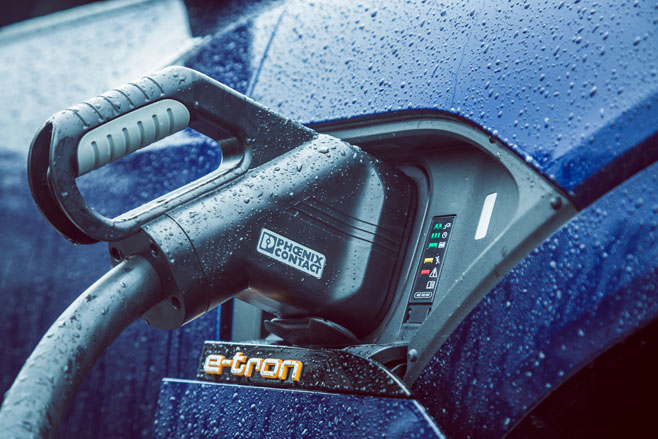
Inside, the Audi makes that extra size apparent in all key areas. It feels a little wider – nice for occupants, but can feel bulky in tight confines for the driver – while there’s a bit more legroom in the second row.
Speaking of which, the floor in the e-tron’s second row is near-flat, whereas the EQC retains the central hump needed by the related GLC for the aft part of its all-wheel-drive system.
The e-tron also makes better use of its under-bonnet space, providing a shallow lidded bin to store the charging cables. The EQC squanders this space, relegating the charging cables to bags that live in the rear cargo compartment.
For the driver, the cockpits are harder to separate in terms of design, ergonomics and functionality. The EQC goes more for a faintly art-deco vibe, while the Audi is all glossy screens, uncluttered beauty and, in the First Edition variant, more premium-feeling surfaces.
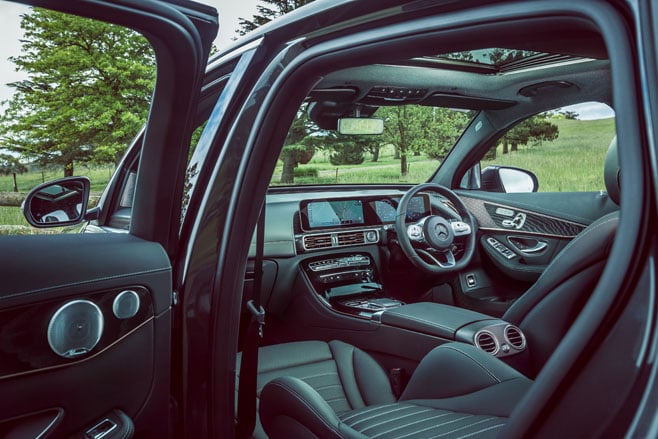
And it’s also the Audi that requires less familiarity to master the infotainment system, although the Merc attempts to counter this via its more sophisticated voice command system.
Weird the way EQC wastes its available screen real estate when Apple CarPlay is activated, though, giving a dinky rendering compared to the more to-scale display of the e-tron.
In terms of seating comfort and adjustability, both are outstanding. The e-tron is slightly more accommodating for larger frames, though those ‘virtual’ exterior mirrors are divisive.
Full points to Audi for innovation, and the slim exterior arms that house the cameras do cut wind noise, but it takes plenty of seat time to get used to glancing at the screens housed in the upper sections of door cards rather than looking outside, and they don’t provide the wide view of a conventional convex mirror when reverse-parking in tight spots.
This, however, is the only touch of ‘future-shock’ on the e-tron, which otherwise seems intent on delivering a driving experience that is both wonderfully familiar yet almost eerily devoid of all the white noise and mechanical clutter we’re used to with regular cars.
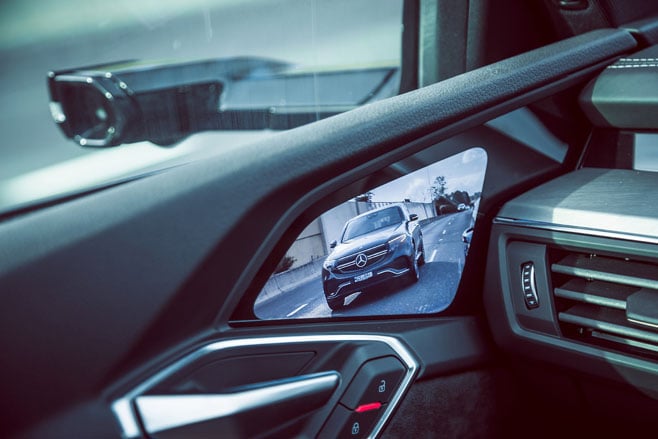
The steering is quick rather than feelsome, but even that is on-brand for Ingolstadt. What’s more noteworthy is the sheer composure and steadfast resolve of the chassis, almost irrespective of which setting you’ve chosen for the adaptive air suspension.
Around town, despite 21-inch wheels, the ride is quiet and absorbent; start hammering it on rural roads and it just keeps finding resolute responses to big challenges thrown at it.
“It never feels analogue – no surprises there,” Ponch comments later, “yet there’s a slick fluency to its dynamics that’s really satisfying. It controls body movement so well; it has a deftness that belies its beef.”
Ponch also manages to out-nerd me by observing that, at least when cruising, the e-tron is the only Audi besides an R8 to be rear-wheel drive. To reduce charge consumption, the front electric motor only comes into operation (instantaneously) under big throttle openings, or when traction or cornering load demands it, and even then the drive split continues to favour the rear with 60 percent.
The Merc? Driven in isolation, you would find it hard to fault the EQC. Loyal readers will recall it shouldered its way to COTY glory in our February 2020 issue thanks in part to “a level of polish and completeness that’s been lacking from any Mercedes SUV that’s gone before it”.
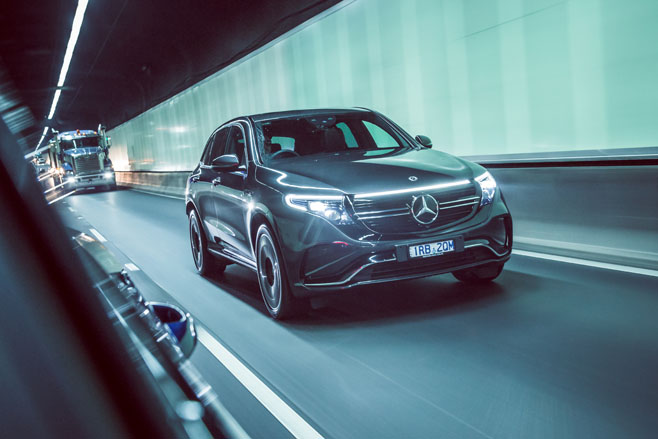
But just as Olympic gold doesn’t necessarily mean a new world record, the top step of the COTY podium has never meant the arrival of automotive perfection. No car is exempt from room for improvement.
What the Merc does have over the Audi is an immediacy and eagerness imparted through the control surfaces. It feels a little more wieldy, a touch more engaging compared to the deliberate softness and buffed lustre of the e-tron.
The nose responds to wheel inputs with a fraction more urgency, and its throttle feels more crisply calibrated in the non-sporting drive mode. Its ride, like the Audi, is wonderfully isolating, and there’s little to split them in terms of cabin quietness; subjectively, the e-tron has a small overall edge, yet some surfaces can introduce hollow-sounding tyre thump.
It’s only when really winding up the wick over demanding roads that dynamic pros and cons start to crystallise.
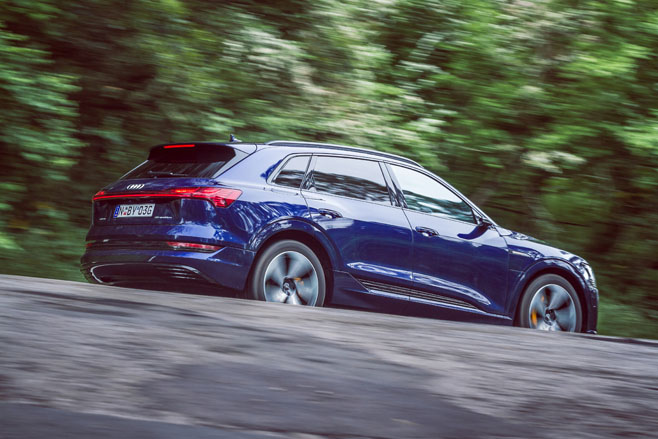
The EQC feels a little more chuckable (if that’s the word for a 2480kg SUV) but can’t quite steamroller the road into submission the way the e-tron manages.
Occasionally a really evil section of mangled bitumen will conspire to expose chinks in the EQC’s strut-front/air-sprung-rear set-up, where front damping resolve throws up the white flag.
Says Ponch: “The EQC is capable of higher highs but also can dip to lower lows compared to the e-tron. The Audi manages a level of supreme consistency and never drops the ball…”
So, for hard-driven dynamic composure, the e-tron manages to nose ahead. But when it comes to the cars’ re-gen functionality, and how seamlessly it works in normal driving, it’s the EQC that claws back points.
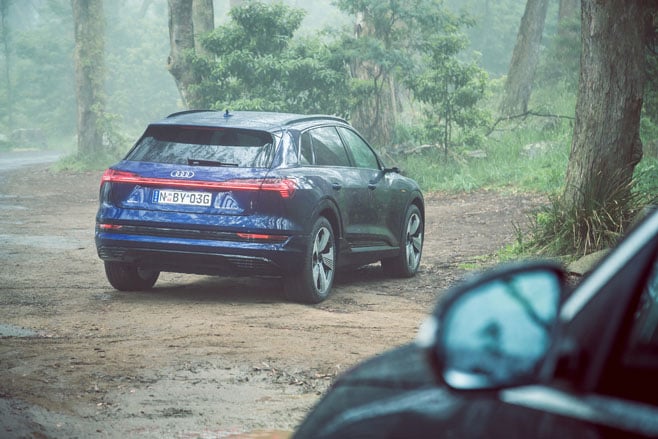
Two quite different approaches are in play here. The e-tron automatically employs a degree of re-gen when approaching other cars or road furniture like roundabouts, yet this can be disabled in the MMI system for a more freewheeling coasting feeling.
But additional re-gen force can be manually added in two levels via one or two pulses of the left-hand wheel paddle. Then, as you re-accelerate, it resets back to normal, awaiting your next input; although the level of re-gen can also be fixed, again via the MMI, giving more of a ‘one-pedal’ feel a lot of EV owners will be attracted to.
The Merc, meanwhile, offers four re-gen calibrations, ranging from ‘barely there’ to the strongest one, which is sufficient to keep you mostly off the brake pedal in stop-start driving.
So, what about the other more mundane but equally crucial stuff attached to EV ownership, like recharging? Well, the qualifier here is that most owners will charge at home, overnight, so differences in fast DC-charging capability may only present themselves on occasional road trips, depending on what your typical usage involves.

But if you do regular long hauls, both cars provide free access to the Chargefox network; the Merc for five years, the Audi for six. Thanks to better thermal management of the battery system, it’s the e-tron that can absorb faster charge rates.
Where available, the Audi can take up to 150kW DC, while the EQC can accept up to 110kW, although there are currently only 14 ultra-rapid chargers on the east coast capable of exceeding this (see sidebar opposite), and regular use of these will adversely impact long-term battery health.
Also, keep in mind that if it’s around 150km or less to a destination charger, both cars can gulp enough energy for that distance in just 15 minutes.

Over an afternoon coffee, Ponch and I agree there are a couple of unavoidable facts to acknowledge about this pair. The first is that neither actually makes a range, output or performance gain over the gullwinged Tesla Model X launched back in 2016. That says either motor efficiency and battery density has plateaued, or that disruptor Tesla got a massive jump on its rivals, from which they’re still playing catch-up, or something else altogether.
The second point is that for the prospective owner who does regular long hauls, the ranges of both EQC and e-tron could be an issue. Highway cruising range from an 80 percent charge will likely be no more than high-200 kays (given a buffer is needed to locate a suitable fast charger), with a recharging time of 30-40 minutes required at each stop, assuming you don’t have to wait for a charger.
But this sort of usage falls to a minority. For most owners currently driving premium SUVs, either of this pair will slot into daily driving life as seamlessly as they both deploy their powertrain power and panache.
As for picking a winner, the easiest conclusion to draw is that there’s no loser. But even ignoring for a moment the price and spec disparity of our two test cars and lining up the EQC against its direct e-tron rival, the 50 quattro SUV (where the price difference is a negligible $200), sees the EQC with battery and output superiority, countered by the e-tron still holding its space and (slim) dynamics advantage.
We’ll give it to the the Audi by a wafer-thin margin, but with both manufacturers promising that this pair are just the start of an EV roll-out across all segments, the broader take-out is this: the future is actually not that difficult to define, and it looks pretty damn enticing.
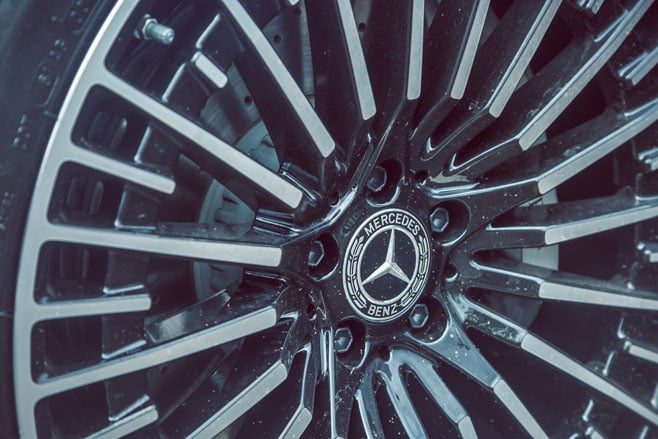
Specifications
u00a0 | Audi E-Tron 55 First Edition | Mercedes-Benz EQC 400 |
u00a0 | $159,000 ($161,300 as tested) | $137,900 ($144,200 as tested) |
Drivetrain | ||
Motors | two | two |
Layout | dual-motor (front & rear) AWD | dual-motor (front & rear) AWD |
Battery | 95kwh lithium-ion | 80kwh lithium-ion |
Power | 300kW | 300kW |
Torque | 664Nm | 760Nm |
Gearbox | single-speed reduction gear | single-speed reduction gear |
Chassis | ||
Body | steel, 5 doors, 5 seats | steel, 5 doors, 5 seats |
L/W/H/Wu2013B | 4901/1935/1629/2928mm | 4774 /1884/1622/2873mm |
Track (F/R) | 1655/1652mm | 1624/1624mm |
Weight | 2490kg | 2425kg |
Boot | 600 litres | 500 litres |
Battery | 95kwh | 80kwh |
Economy | 28.5kwh/100km (test average) | 28kwh/100km (test average) |
Suspension | Front: muti-links, adaptive dampers, air springs, anti-roll bar Rear: multi-links, adaptive dampers, air springs, anti-roll bar | Front: struts, adaptive dampers, coil springs, anti-roll bar Rear: multi-links, adaptive dampers, air springs, anti-roll bar |
Steering | electric rack-and-pinion | electric rack-and-pinion |
Front Brakes | ventilated discs (370mm) | ventilated discs (360mm) |
Rear Brakes | solid discs (360mm) | ventilated discs (360mm) |
Tyres | Continental Sportcontact 6 | Michelin Pilot Sport 4 |
Tyre Size | 265/45 zr21 (f/r) | 235/45 zr21 (f); 265/40 zr21 (r) |
Safety | ||
ANCAP Rating | not tested (aus) | not tested (aus) |
Verdict | ||
u00a0 | 8.5/10 | 8.5/10 |


